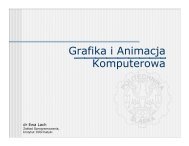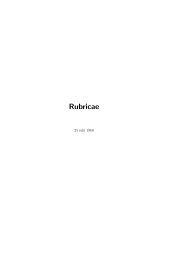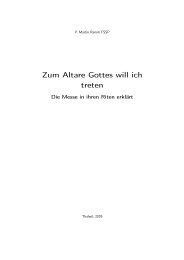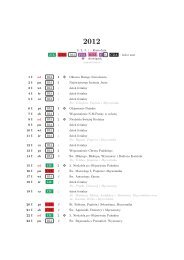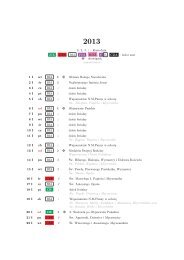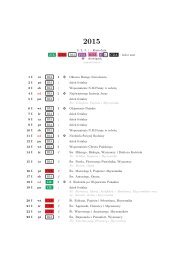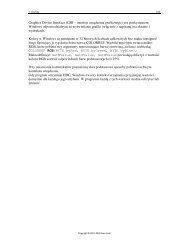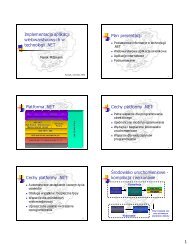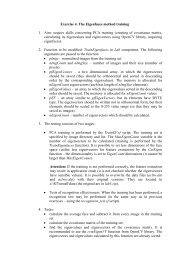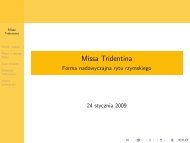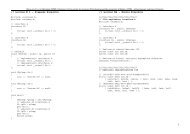A System to Adapt Techniques of Text Summarizing to Polish
A System to Adapt Techniques of Text Summarizing to Polish
A System to Adapt Techniques of Text Summarizing to Polish
You also want an ePaper? Increase the reach of your titles
YUMPU automatically turns print PDFs into web optimized ePapers that Google loves.
people they-pay with-health', 'The youth pay for their<br />
unwisdom with their health'), we get four syntactic groups:<br />
• NG1 – nieroztropność (unwisdom)<br />
• NG2 – młodzi ludzie (young people)<br />
• NG3 – zdrowiem (with-health)<br />
• VG1 – przypłacają (they-pay)<br />
All these groups are combined <strong>to</strong> a sentence S1 =<br />
{NG1,NG2,NG3,VG1}, based on the verb group VG1. For<br />
VG1 we find in the dictionary a schema:<br />
Ngn1+VG1+Ngac-c2+NGi3. Then we assign the syntactic<br />
groups <strong>to</strong> the schema. There is a result:<br />
• subject: NG1 or NG2<br />
• predicate: VG1<br />
• object in accusative case: NG1<br />
• object in instrumental case: NG3<br />
There are two candidates <strong>to</strong> be a subject, but NG1 is the<br />
only one candidate <strong>to</strong> be an object in accusative case, so NG2<br />
is the subject. In this case a full semantic analysis <strong>of</strong> syntactic<br />
groups is not required.<br />
B. Supplementing the results <strong>of</strong> the linguistic analysis<br />
Missing elements <strong>of</strong> a syntactic schema <strong>of</strong> a sentence are<br />
determined basing on the results <strong>of</strong> the semantic analysis.<br />
Either a subject, an object, or a predicate can be missing. If<br />
necessary, the results <strong>of</strong> the analysis are supplemented by a<br />
predicate group (VG) or a subject or object group (NG).<br />
Syntactic schemata are also used here. After assigning the<br />
syntactic groups <strong>to</strong> the schema, the schema can be partially<br />
filled. This situation occurs when some syntactic group from<br />
the sentence is an anaphora. We can read syntactic features,<br />
semantic features, and a syntactic role <strong>of</strong> the anaphora from<br />
the schema. Then the analysis <strong>of</strong> anaphoric relations is more<br />
precise. If the anaphora is an ellipsis, then we add a proper<br />
pronoun as a subject or an object. If a predicate is missing,<br />
then we add the verb 'być' ('<strong>to</strong> be') in a proper form. The<br />
algorithm <strong>of</strong> supplementing the missing words is not so<br />
sophisticated. In a future version we plan <strong>to</strong> improve it, using<br />
an analysis <strong>of</strong> ellipses.<br />
C. The analysis <strong>of</strong> anaphoric relations<br />
The analysis <strong>of</strong> anaphoric relations is divided in<strong>to</strong> three<br />
stages: searching for an anaphora, searching for a target <strong>of</strong> the<br />
anaphora, and determining how <strong>to</strong> substitute the target for the<br />
anaphora. As a result, we get information about sentence<br />
interconnections, and how <strong>to</strong> keep these connections, i.e.<br />
which form <strong>of</strong> the target has <strong>to</strong> be substituted for an anaphora.<br />
The problem <strong>of</strong> anaphoric relations analysis [7]-[9] is<br />
complex, so we focused only on some subset <strong>of</strong> anaphora. At<br />
present we take only pronouns and some conjunctions [10]<br />
in<strong>to</strong> account. It should be noticed that a missing subject is<br />
supplemented by a pronoun in a previous stage<br />
(supplementing the results <strong>of</strong> the linguistic analysis). We do<br />
not take in<strong>to</strong> account such anaphoras that repeat some notion,<br />
which occurred earlier in the source text. To take in<strong>to</strong> account<br />
these anaphoras we should use a database <strong>of</strong> term dependency,<br />
for example thesaurus.<br />
We made assumptions while searching for anaphora targets<br />
(antecedents): we look only backward in the scope <strong>of</strong> two<br />
simple sentences (we do not look forward), we take in<strong>to</strong><br />
account only separate words. Since an anaphora can target <strong>to</strong><br />
another anaphora, so indirectly the scope is wider than two<br />
sentences. We select an antecedent from candidates using the<br />
following criterion:<br />
• it must belong <strong>to</strong> a noun group (NG)<br />
• its gender must match with the gender <strong>of</strong> anaphora<br />
• if it is an anaphora, then it must be joined with an<br />
antecedent<br />
If there are still some candidates left, then we select from<br />
them exactly one. A function <strong>of</strong> a syntactical group containing<br />
the antecedent is the main criterion <strong>of</strong> selecting the<br />
antecedent. The preference is as follows (the most important is<br />
the first):<br />
• subject function<br />
• other function (for example object)<br />
• no function<br />
As a result it returns the information how <strong>to</strong> substitute the<br />
antecedent for the anaphora. This information can be used by<br />
the system or not. To perform this substitution, we take the<br />
base form and the type from the antecedent, but the features<br />
from the anaphora. If the anaphora features and the antecedent<br />
features differ, then we have two solutions: generate a proper<br />
form <strong>of</strong> the antecedent or leave the base form. Since <strong>Polish</strong> is<br />
an inflected language, we try <strong>to</strong> generate a proper form <strong>of</strong><br />
antecedent. In this way the generated text is more readable by<br />
human.<br />
To generate a proper form <strong>of</strong> antecedent we use<br />
morphological database [11]. The morphological database<br />
contains a morphological description <strong>of</strong> over 50 thousand<br />
<strong>Polish</strong> words, including over 30 thousand nouns (presently<br />
only nouns take part in anaphora resolution). It is s<strong>to</strong>red in an<br />
acyclic finite-state au<strong>to</strong>ma<strong>to</strong>n that represents the relation<br />
between text forms and words with their grammatical<br />
attributes. While the database recognizes variant word forms<br />
(which occur in 1 <strong>Polish</strong> noun out <strong>of</strong> 8) when used <strong>to</strong> analyze<br />
texts, it outputs only the most prevalent variant form when<br />
used <strong>to</strong> generate texts.<br />
The use <strong>of</strong> this database required creating an interface layer<br />
because the set <strong>of</strong> grammatical attributes used in the database<br />
differs from that used in the system. Specifically, all requests<br />
are translated from a 3-gender, 7-case system in<strong>to</strong> a 4-gender,<br />
8-case one. Also, the system distinguishes the nouns<br />
according <strong>to</strong> their nominative form, while the database takes<br />
in<strong>to</strong> account the whole declension paradigm. The format <strong>of</strong><br />
the request is: (a noun in nominative, its gender [masculine,<br />
feminine or neuter], its number [singular or plural], its case<br />
[nominative, genitive, dative, accusative, instrumental,<br />
locative, vocative]).<br />
Example nouns that decline differently depending on their<br />
meaning are: 'pilot' ('pilot' or 'remote control'), 'rząd'<br />
('government' or 'row'). For such nouns a set <strong>of</strong> pairs (possible<br />
form, internal code <strong>of</strong> the noun) is generated. To distinguish



